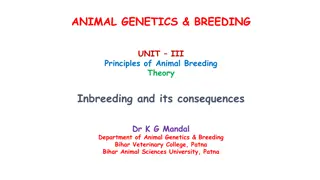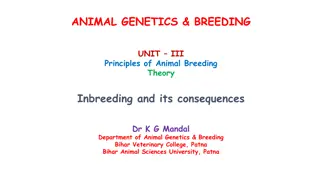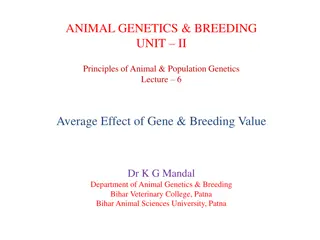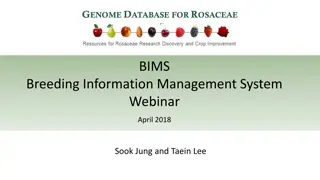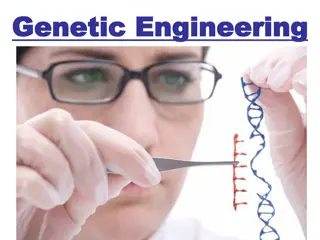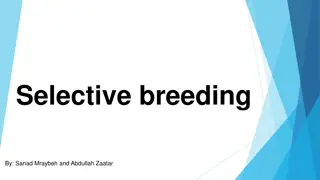Guide to Efficient Rodent Breeding and Colony Management
This comprehensive guide covers essential aspects of rodent breeding, colony management, and tips for successful rodent reproduction. It includes details on weaning, retiring breeders, records management, problem-solving, resources, goals and planning, breeding systems, reproduction processes, genotyping, and environmental factors. Learn about setting goals for breeding programs, selecting appropriate breeders, maximizing offspring quality, maintaining genetic authenticity, and more. Explore different mating systems, such as harem breeding, monogamous/pair breeding, and timed mating systems, with their advantages and disadvantages outlined in detail.
Download Presentation

Please find below an Image/Link to download the presentation.
The content on the website is provided AS IS for your information and personal use only. It may not be sold, licensed, or shared on other websites without obtaining consent from the author.If you encounter any issues during the download, it is possible that the publisher has removed the file from their server.
You are allowed to download the files provided on this website for personal or commercial use, subject to the condition that they are used lawfully. All files are the property of their respective owners.
The content on the website is provided AS IS for your information and personal use only. It may not be sold, licensed, or shared on other websites without obtaining consent from the author.
E N D
Presentation Transcript
RODENT BREEDING: COLONY MANAGEMENT AND TIPS
OUTLINE Weaning Retiring Breeders Records Problems Resources Goals and Planning Breeding Systems Rodent Reproduction Pregnancy Pup Development Identification/ Genotyping Environmental factors
GOALS & PLANNING Basic goals of an efficient breeding program: Maximize output relative to costs Select appropriate breeders Replace unproductive breeders Maximize quality of offspring Produce healthy animals Maintain genetic authenticity Uniformity of offspring Have supply match demand Reduce waste (3Rs = Reduction, Refinement, Replacement) Enhance flexibility
GOALS & PLANNING Goals: Certain gene or multiple? One or both sexes? A certain number at specific age at same time? How many: Total number? Number per week/month/year? # of Breeders: Depends on type of mating system, strain, litter size, mothering, and pup survival. How long: Depends on mating system, intervals between breeding, number of initial available breeders.
MATING SYSTEMS Three common mating systems: Harem breeding (1 male and 2 or more females) Monogamous/pair breeding (1 male and 1 female) Timed mating system
HAREM BREEDING One male is housed with two or more females continuously Used for inbred, transgenic or other strains that usually generate small numbers of pups or difficult to breed. Must be approved in AUP Total number of animals may not exceed cage capacity Each female must have a completed standard breeding cage card
HAREM BREEDING Advantages Disadvantages Maximizes number of litters per female Each female must be separated once it shows signs of pregnancy Fewer males needed Increased labor separating animals Easier to identify poor breeders Postpartum estrus is lost Easier to identify good or bad moms Increased observation Improved production control (male rotated among females that were separated) females will only become pregnant when placed with a male again Multiple females may complicate recordkeeping of lineage
MONOGAMOUS/PAIR BREEDING Monogamous 1 male and 1 female Female removed from male while pregnant (at 10-14 days, or less) Female stays with male (Postpartum estrus)
MONOGAMOUS/PAIR BREEDING Advantages Easier to identify poor breeders Easier to identify good or bad moms Simplified record keeping Disadvantages Increased labor separating animals (if separating female) Postpartum estrus lost (if separating female)
TIMED MATING SYSTEM Use when exact date of gestation must be known Female placed in stud male s cage Check for plugs in the EARLY morning (6 am) NOTE: Plug indicates copulation but does not guarantee pregnancy
TIMED MATING SYSTEM Advantages Exact date of conception known Disadvantages Labor intensive Plug Pregnant Embryo age Infertility Fetal age Plug lost prior to check Expected parturition date Place female mice into male s cage https://www.jax.org/news- and-insights/jax- blog/2014/september/six- steps-for-setting-up-timed- pregnant-mice
RODENT REPRODUCTION Reproductive Data Stage Average Sexual Maturity Estrous frequency Estrous duration Gestation Average litter size Pups eat dry food Weaning age Reproductive life Life span 40 60 days (6-8 weeks) 4 5 days 14 - 28 hours 18 - 21 days (avg) 4 12 11 14 days 21 days ~ 8 months 1 3 years
SELECTING BREEDERS Select animals that are: Healthy and well groomed Animals that are barbered, bitten or runted are poor choices Genetic drift and fidelity to original source Males and females should be approximately the same size Select for desired genetic authenticity Homozygous, heterozygous, or hemizygous Avoid selecting animals too old or too young Reduced pregnancy rate Unthrifty litters Usually not good moms Increased dystocia
STRAIN CHARACTERISTICS Some breeding characteristics vary between strains Age to breed Litter size Strains that are poor breeders will require more breeders to produce an equal number of offspring
CONSISTENT PRODUCTION Maintain a minimum of three (3) to four (4) breeder cages of various ages Staggering parents birthdates 2 to 4 months will assist in maintaining a strain/line Assist with viable (successful) births When production level declines or a max of 7 litters are born, replace with new/young breeders
ENVIRONMENTAL FACTORS Causes of stress: Vibration: Ex: Construction or heavy machinery nearby, failing IVC racks Noise level and ultrasonic frequencies High traffic Handling- picking up mice by the tail induces high anxiety - use tubes Reducing stress: Breeding cages should be kept in low traffic area with consistent staff/researchers Provide a consistent light/dark cycle Limit handling Provide enrichment Noise level should be kept at a minimum
ENRICHMENT Cardboard and/or plastic tube/tunnel Shredded paper pucks Bed-r'Nest Shepherd shacks Nestlets - cotton square Purchase from OLAC website as a Non-Animal Purchase Request Pick up from Supervisor Office in WH.6th floor or NAF https://olac.berkeley.edu/form/non-animal-order
BIOLOGICAL FACTORS Whitten Effect (can combine with Lee-Boot to induce estrus) Exposure to male (viable) dirty bedding (urine/pheromones) will stimulate estrus in females (pheromones are airborne and taken up by olfactory in females) If male scent is introduced to multiple females housed together, they will cycle in unison - useful for timed matings Females will enter estrus within 72 hours of introduction Lee-Boot Effect (can combine with Whitten to induce estrus) In group housed females, with no exposure to males release an estrogen dependent pheromone via urine and lowers the luteinizing hormone and elevates prolactin levels synchronising or stopping the estrous cycle. Spontaneous psuedo-pregnancy due to pheromone exposure may occur Bruce Effect Introduction of a strange male (including scents dirty bedding/urine) after mating will prevents implantation and terminate pregnancy Wait 10-14 days before introducing to a new male IMPORTANT: Keep gloves sanitized/clean, use sanitizer between cages, and keep a clean/sanitized cage changing station.
RECORD KEEPING IS CRUCIAL Breeding Cage Cards - request on OLAC website 5 rows for litters Date Mated, Birth Date, # Born must be completed (Separated is completed only if separating a female/male) Wean Date - is completed upon weaning (including sex # s is helpful ex: 3M, 5F) 2/14/21 #321, 12/10/20, C57BL6 +/ #321, 12/10/20, C57BL6 +/- - #12 11/02/20, mT/m +/+ #12 11/02/20, mT/m +/+ 8 2/14/21 3/16/21 4/7/21
WELL KEPT RECORDS PROS Identifying ancestors, siblings, and descendants via pedigree records Monitoring mating activity - observation of decline in litters Identifying individuals used in experiments - use positive controls when genotyping! Selecting next generation of breeders - sister/brother matings are most common Maintaining strains and genetic lines - refresh colonies after no more than 10 generations to maintain genetic fidelity for research
ACCEPTABLE REASONS FOR SINGLE HOUSING Breeding: Separating animals Single house males after breeding! Do not rehouse a male with other males after removing from a breeding cage Aggression: Removing the aggressor Protocol: Experimental purpose described in AUP Attrition: Animal is alone in cage due to death or experimental use of cohorts Medical: Animal is alone for treatment or other reasons Whenever an animal is singly housed, the top portion of the card must be marked with the reason and the date Note: Females can be housed/mixed Keep notes of ID/ages on the card
DETECTING PREGNANCY Observation Plug checks (does not guarantee pregnancy) Swollen abdomen in later stages (10-21 days) Palpation ~ 10 days (sometimes earlier) Parturition Small litter size ~ 1-4 pups
Determining Age of Pups https://oacu.oir.nih.gov/system/files/media/file/2021-02/jaxpupsposter.pdf
IDENTIFICATION Methods Ear punching or notching Ear tags Microchips Tattoos Toe Clipping must be approved in AUP
GENOTYPING Tail and Ear Samples Should be collected as early as possible (usually around 7 days old) Note: can be earlier No general anesthesia necessary Allows for resampling before weaning, if necessary Lowers cage numbers => Lowers per diems Ear samples: Can be used for identification Note: Genetic monitoring is important
WEANING & SUPPORT Strains that produce smaller pups and need delayed weaning (21-28 days): Must be on AUP Submit Special Service Request https://www.olac.berkeley. edu/special-services- request-0 Separate male from female before birth (Will assist with avoiding rebreeding at postpartum estrus) Provide supplemental care early, at age 14 -21 days Weaning should occur by 21 days Can be weaned as early as 14- 18 days Must have supportive care Wet Food on floor of the cage or in a pup cup Nutri-Cal, DietGel, etc. Can order from OLAC, https://www.olac.berkeley.e du/non-animal-order
DETERMINING SEX IN PRE- WEANED RODENTS Mice and rats can be sexed at birth Younger pups are more difficult! Males have a longer distance from the genital papilla to the anus than females. Males have a black dot in the genitilia area and females do not black dot Female Male As pups get older They can still be sexed by the greater anogenital distance for males and the shorter anogenital distance for females Nipples are now visible in females 1-3 day old mouse pups Closer to weaning age Females will have a thin fur-less strip anogenital distance Males will have full fur in anogenital distance Nipples Female Male
OVERCROWDED CAGES ACUC Overcrowded Mouse Cage Guidelines Must be followed https://acuc.berkeley.edu/guidelines/overcrowded.pdf No more than 5 adults per cage (same sex or harem breeding) Pups should be weaned by 21 days (unless approved in the AUP) Lab members/PI are required to check for pregnancies and litters daily (including weekends and holidays).
RETIRING BREEDERS Retire: Females 8 -10 months old or after 8 litters Males 8 months to 1 year of age Replace unproductive breeders Females that produce two (2) consecutive litters that are not viable or cannibalization Unproductive males: after ~ 3 to 5 weeks with a proven female (have had a prior litter) productive pregnancy
TROUBLESHOOTING Environmental Factors: Light cycle interrupted? Make sure hood light is off in room Do not enter the room after lights are off Location of breeders? High foot traffic, near door? Top or bottom of rack? Move to middle of rack, away from main traffic flow in room Too much handling right before or after birth? Consider putting a tunnel in the cage Temperature & humidity - check room log sheet Noise, ultrasonic? Check equipment in room is in good working order Construction vibrations - little control on this, consider move off site or outsource Cage environment - add nesting material & paper shacks Contact the Facility Supervisor for questions about room issues: supervisor@berkeley.edu or olac@berkeley.edu
TROUBLESHOOTING No pregnancies/inconsistent pregnancy and small litter size Verify a male and female are the in cage Evaluate age of breeders Rotate males/females with proven breeders - (after ~ 10 days) Add breeder diet 5058 or irradiated sunflower seeds A SSR is NOT needed Request stickers from Facility office Just add yellow sticker to your cages and replace feed at the same time Dam neglects pups (no milk spots) - first litter, Example: C57BL/6 Cannibalization Was the dam disturbed a few days before or after parturition? First litter? (common in C57BL/6 strain) Males may cannibalize litter in some strains Remove male from mating cage before female gives birth
FOSTERING PUPS Dam doesn t care for any litter Are the pups valuable pups? Choose an experienced dam, who has successfully raised a litter, from your colony (or buy FVB/NJ, CD-1, or Swiss Webster timed pregnant females) Cross foster (identifying the pups and record keeping is crucial) Introduction method Have the dam urinate on the pups Place new pups in nest (scent and mix with other pups) Introduce foster mother and observe behavior. Monitor for rejection and check the following day
ISOLATED PROBLEMS Dystocia Check for vaginal septum (rare!) Consider condition of mom and importance of pups Interventions: Consult Vets ASAP (ext. 3-VETS , (510) 643-8387), or vetstaff@lists.berkeley.edu Remove malpositioned pup Consider cesarean section if the pups are valuable Euthanization Unexpected results or phenotypes Review: Breeding records Cage cards (example: correct breeding, strain and etc) Genotypes Consider eliminating if no explanation Note: if the genetic background is refreshed ~ every 5-10 generations genetic drift is reduced.
CRYOPRESERVATION Strain Problems & Outside Services: Cryopreservation, embryo transfer, and/or IVF Ovarian transplantation Overcomes female breeding, implantation, or gestation problems In vitro fertilization (IVF) Overcomes male or female fertilization problems Cryopreserve important strains!! https://www.jax.org/jax-mice-and-services/colony- management/cryopreservation https://www.jax.org/jax-mice-and-services/colony- management/strain-rescue - $5,575/strain/attempt (Estimated cost in 2021)
ANY QUESTIONS? Email: olactraining@berkeley.edu Request for additional information or training: OLAC Certifications, Training & Breeding Info https://forms.gle/xdyxAGFZ1rFjaKBE6





